This vegan green Thai vegetable curry is really easy to make; you just need to get ready for an avalanche of flavor and grab those forgotten veggies in your fridge. Plus a couple of queues!

I have been making Thai curries and Thai food in general for more than 15 years now. It is my true comfort food and also my comfort zone. I know our dinner will be rich, delicious, easy, and fast, and I always make it with a few kitchen staples.
Of course, I have my preferences, such as making it with coconut milk, pairing it with Jasmine rice, or topping it with crispy tofu, peanuts, and/or sprouted soybeans. But I never let the lack of any of these ingredients keep me from making this one-pot dish.
Jump to:
🤔 Origins of Thai Curry
The Tamil word "kari" refers to any kind of sauce or stew, and the English word curry derives from it. As a result, the term "curry" is very inclusive and may be used to refer to any type of meal, stew, or sauce.
The British introduced curry to Thailand by Thai people who traveled through India and had curry while traveling there. The Thai people changed the Indian version of curry into something more like what it is today.
The first curry restaurant that sold Thai curry was in Thailand, and Thais opened it. The curry restaurant still exists today and is called " khao phat nam phrik Narok" which means fried rice with Thai chili paste.
Curry has many different names in Thailand, with each province its own variation of curry sauce. The national dish of Thailand is curry. Thus, it is extremely popular.
Also, the Curry in Thailand is made with ingredients not often used in other Indian or Thai curry types, such as potatoes, peanuts, pineapple, and herbs that are more common in Thailand.
If you like Indian Curries, you should try our Masala Eggplant Curry and Curried Cauliflower.
🧾 Ingredients
I will cover the basics for making a vegan green curry, the flavor deliverers, and options (including a link to our post on How to make Vegan Thai Green Curry Paste.

- Sweet Potato: Adds a natural sweetness and creaminess to the dish while packing a nutritional punch with vitamins and fiber.
- Eggplant: Provides a meaty texture and absorbs flavors well, making it a versatile addition.
- Shallots: Offer a milder, more nuanced flavor than regular onions, enhancing the overall taste profile.
- Peanuts: Contribute a crunchy texture and nutty flavor while also adding some protein to the mix.
- Coconut Milk: Creates a rich and creamy base, complementing the spices and adding a tropical twist.
- Green Curry Paste: Acts as a flavor powerhouse, infusing the dish with herbs and spices in one convenient ingredient.
- Ginger: Brings a zesty kick and aromatic depth, while also offering digestive benefits.
- Coriander Leaves: Freshen up the dish with their citrusy notes and add a pop of color for visual appeal.
- Sesame Oil: Elevates the flavor with its nutty, aromatic qualities; optional for those on a WFPB diet.
- Water or Vegetable Stock: Serves as the liquid base, with stock adding extra flavor and nutrients if chosen.
Top tip: a little fresh lime juice adds a nice touch of acidity; just squeeze the lime wedges directly into your plate.
🔪 Instructions
To make this eggplant green curry recipe, I will describe the method using my preferred veggies and toppings while offering the substitutions and when to add them.
- Stir-fry the shallots, sesame oil, and cashews (or peanuts) for 1-2 minutes on high heat until slightly browned.
- Add green curry paste, ginger, and shallots (or chopped onion), and stir for another minute. If using tamarind paste, add it at any point from now.
- Add the coconut milk and bring to a boil on medium-high heat.
- Add the “sturdy/hard” vegetables such as diced sweet potato (or potatoes) and carrots, plus eggplants which require a little more cooking time.
- After 5 minutes, pinch the veggies. Add the water (or vegetable stock) and some cilantro leaves when they are slightly soft. Next, add the “soft” veggies, such as diced zucchini, and let them boil for another 10 minutes.
- Halfway through these last 10 minutes, I like to taste for flavor. Add some salt if you want to. You can add a teaspoon of Thai green curry paste or grated ginger for extra flavor.
- Turn off the heat and stir in the spinach and/or Bok Choy and Green Beans.
- At this point, I also add half of the crispy baked tofu. This way, it can absorb some curry juices without losing their crispiness.
- Cover with a lid on and let it rest for 5-10 minutes.
- Serve with any of the suggested toppings. I like to add them all.
This homemade eggplant green curry tastes even better the day after, so I recommend you make a lot! 🙂
Top tip: add vegetable broth while boiling to make it more liquid. If you need to thicken it up, you can dilute one tablespoon of corn starch in half-cup water and add it to the eggplant green curry while boiling. It should thicken up after a minute.
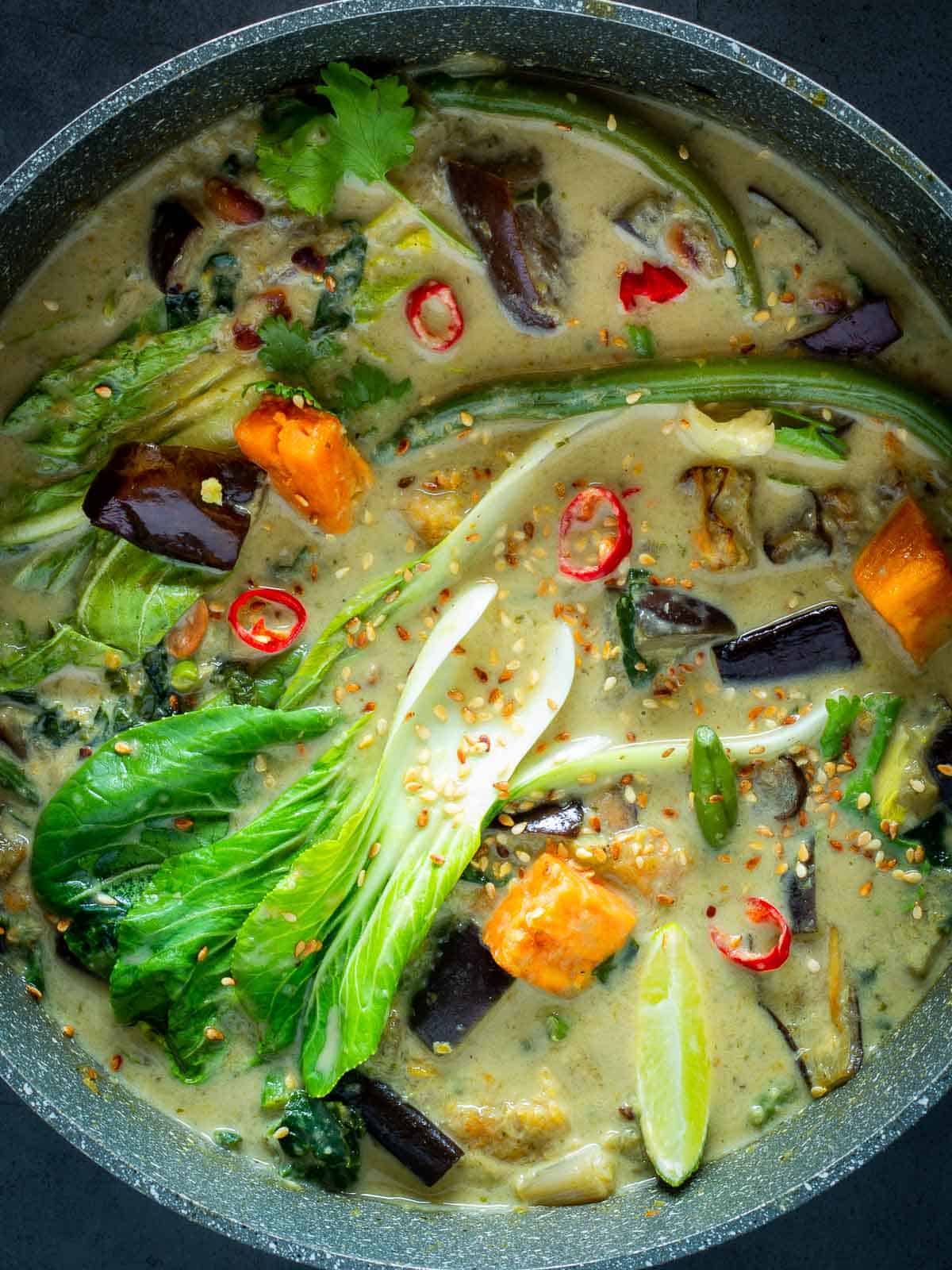
🥢 How to serve
Serve this Vegan Thai Green Curry recipe with freshly steamed Jasmin Rice.
You can have lime juice and soy sauce on the table if you want to bring additional acidity or umami flavor to your plate.
We also like adding red pepper flakes and baby corn as garnishing.
If you want to make a nice Asian appetizer, go for something easy, and flavorful that doesn't require additional plates, like this unshelled, 10-minutes spicy garlic edamame recipe.
Although the curry flavors are fresh, they are also spicy, making it an excellent fall curry recipe.
Toppings and garnishing
I like adding some toppings to make it beautiful and add some texture.
Nuts and seeds
Cashews, peanuts, or toasted sesame seeds.
Extra crunch and flavor
Soybean sprouts, green ends of spring onions, or cilantro leaves.
Crispy tofu
Just as in any Thai restaurant, they offer to pair your curry with your choice of chicken or shrimp. I like my Thai green curry with Crispy tofu and/or green beans. This is easily made in the oven while you wait for your curry to be ready.

Vegan and Homemade Curry paste
Try making your own Vegan Thai Green curry paste or Yellow Curry Paste, it lasts for months in the fridge, and you can use it to season many dishes.
If you are looking for an Indian-style Curry, you should try this Eggplant Curry, which is equally delicious. Also, our Vegan Chili is a delicious quick, one-pot recipe that your family will love!
❓ FAQ
Green and red curry are both popular types of Thai curries, but there are actually quite a few differences between them. The most noticeable difference is the type of chili peppers used to make each one. Green curry typically uses green chilies like jalapeños or Serranos, while red curry usually uses dried red chilies such as cayenne pepper and dried Thai peppers. This means that green curry is generally milder than red curry as the chilies in green curry tend to have a lower Scoville rating—the measure of how spicy something is.
In terms of flavor, red curry tends to be more complex due to the longer cooking process and different spices used in its preparation. Red curries often include ingredients like garlic, ginger root, lemongrass, coriander seed, cumin seeds and galangal which all create distinct flavors. On the other hand, green curries can vary greatly depending on individual recipes but they tend to rely mainly on lemon grass for its distinctive citrusy taste along with other herbs and spices like white pepper or turmeric for depth of flavor plus coconut milk for creaminess and sweetness.
🇹🇭 More Thai curry recipes
Try our Thai Fresh Red Curry, Vegetable Yellow Curry, Red vegetable curry, Massaman Vegetable Curry, and the delicious coconut pineapple curry, made with red curry paste.
We love this chickpea coconut curry made with Massaman Curry.
⭐ If you try this recipe, let us know! 💬 Leave a comment, rate it, and don't forget to tag us @ourplantbasedworld on Instagram. Cheers!
📋 Recipe
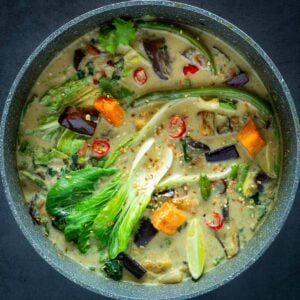
Green Thai Vegetable Curry
Equipment
Ingredients
- 10 oz sweet potato diced
- 1 eggplant medium, diced
- 3 shallots
- 1 oz peanuts a handful
- 8 oz coconut milk add more if want it creamier
- 2 tablespoons green curry paste
- 2 tablespoons ginger freshly grated
- 1 cup coriander leaves, about a bunch, chop only half
- 1 tablespoon sesame oil optional, omit if following a WFPB diet
- 3 cups water or vegetable stock
Optional extras:
- 10 oz green beans without tops
- 1 tablespoon sesame seeds
- 2 bunch bok choy
- 2 tablespoons tamarind paste
- 2 cups spinach about 2 bunchs
- 8 oz crispy tofu see recipe
- sea salt to taste, optional, omit if following a WFPB diet
Serve with
Directions
- Stir-fry the shallots along with sesame oil and cashews (or peanuts) for 1-2 minutes on high heat until slightly browned.
- Add the curry paste, ginger, and stir fry for another minute. If using tamarind paste, add at any point from now.
- Add the coconut milk and bring to a boil.
- Stir in the veggies. Add the “hard” vegetables such as diced sweet potato (or potatoes), plus eggplants which require a little more cooking time.
- Pinch veggies. After 5 minutes, pinch the veggies. When they are slightly soft, add 3 cups of water and some cilantro leaves. Next, add the “soft” veggies, such as diced zucchini, and let them boil for another 10 minutes.
- Adjust. Halfway through these last 10 minutes, I like to taste for flavor. Add some salt if you want to. You can also choose to add an extra teaspoon of curry paste or grated ginger for extra flavor.
- Turn off the heat and stir in the spinach and/or Bok Choy and Green Beans.
- Add tofu. At this point, I also add half of the crispy tofu. This way so it can absorb some of the curry juices without losing their crispiness.
- Cover. Place the lid on and let it rest for 5-10 minutes.
- Serve with any of the suggested toppings. I like to add them all.
Video
Nutrition Facts
Nutritional Disclaimer
The information shown is an estimate provided by an online nutrition calculator. It should not be considered a substitute for a professional nutritionist's advice. See our full Nutritional Disclosure here.
Affiliate Disclaimer
Please note that some of the links here are affiliate links, and I will earn a commission if you purchase through those links. I recommend all of the products listed because they are companies I have found helpful and trustworthy.
As the lead content writer and recipe developer at Our Plant-Based World, he combines his passion for health and sustainability with a Plant-Based Nutrition Certification to create accessible, delicious vegan recipes. His expertise in plant-based cooking supports the blog's mission of fostering a healthier, environmentally conscious lifestyle through simple and seasonal dishes. His commitment to making vegan cooking enjoyable and inclusive for everyone shines in each recipe and article.

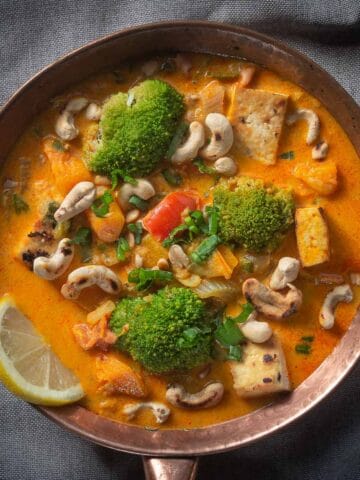
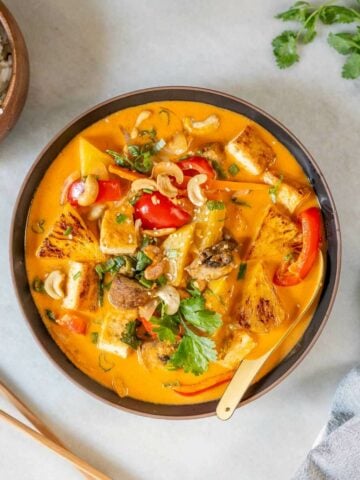
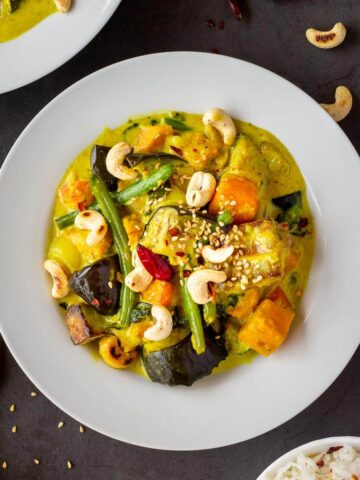
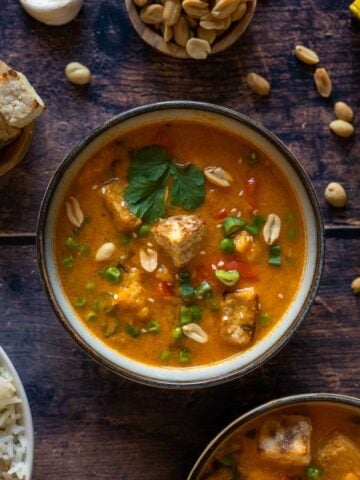




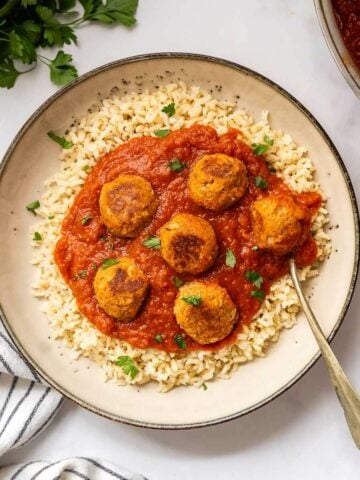
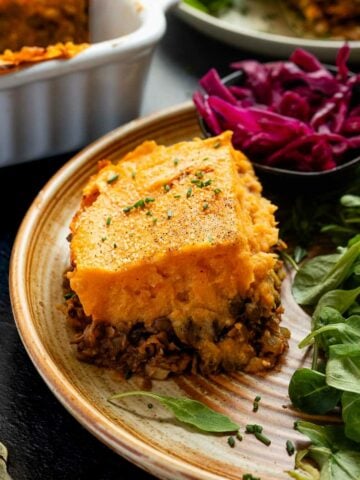
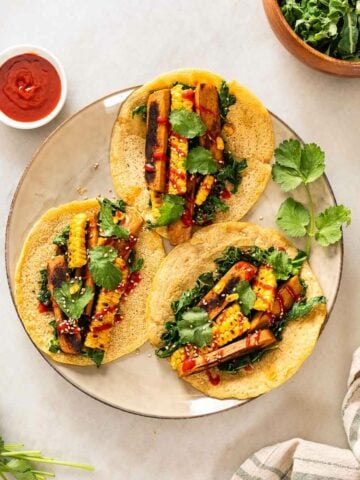
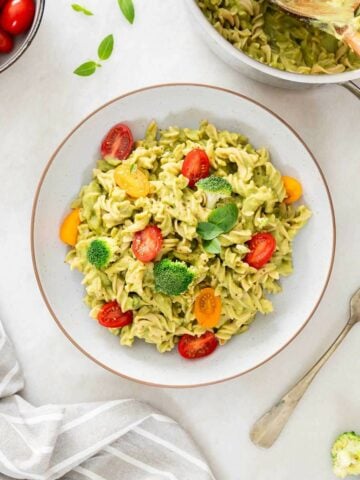
Anaiah
I am LOVING this vegan eggplant curry! I have never tried adding tamarind paste in my Thai green curry before but it enhances all the flavors. Great recipe!
Gus
Thank you for your kind words Anaiah! I am so happy that you enjoyed the recipe and found it to be delicious. The tamarind paste is a great addition, we love it too!
nancy
this thai dish is super flavourful and well balanced. i love how it's packed with so much veggies! lilterally a meal on its own
Jan
I am so pleased with this curry, it's packed with veg and flavour.
Michelle
Oh my GAWD this is the most amazing curry!!! One of the best I've ever had, I love that the ingredients are really unique compared to what I usually get in curries.
Gus
hey Michelle! Thank you for your review! I am glad you enjoyed this green curry! It is a FAV here, we are actually having it for dinner tonight, I love having it with a glass of pinot grigio!
Katie
I love this green curry! I really love the plant diversity in this recipe, so healthy and delicious!
Suja md
This recipe tasted great and we were pleasantly surprised on how easy it was, will make it again for sure!